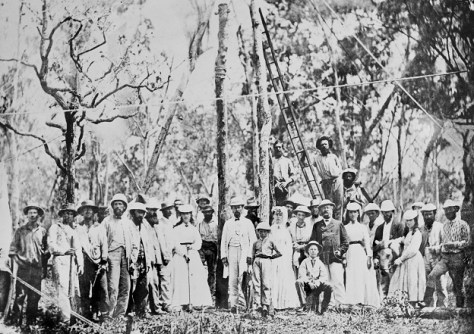
This article was first published in Issue 123 (Feb/Mar 2023) of Position magazine.
Surveyors played a critical role in scouting the inland route for the telegraph line that connected Australia to the world.
By Tony Proust
Most people know the story of the Snowy Mountains Scheme, arguably Australia’s greatest engineering and surveying achievement. But what about the Overland Telegraph Line (OTL), built 80 years earlier? I didn’t know much about the OTL until my wife and I did a road trip through the Red Centre in early 2022 and subsequently read the recent book, Twenty to the Mile – The Overland Telegraph Line, by Derek Pugh.
Surveyors were critical to the success of the OTL. Pugh details many of them, including Surveyor William Harvey who conducted route-finding in northern South Australia in 1870. Near Mount Samuel, Harvey had difficulty with his theodolite because the hill was ‘crowned with immense ironstone rocks’ rendering the compass needle useless.
The greatest challenge facing Australia in the early 19th century was the tyranny of distance. Until the OTL was built in 1872, the fastest that news could travel from the UK to Australia was three months on the famous clipper ships. But upon commissioning of the OTL in October 1872, news could reach Australia from the ‘home country’ in a day, which was extraordinary.
In 1862, surveyor and explorer John McDouall Stuart was the first European to traverse the mainland from south to north through the centre of the continent, and, in 1863, South Australia annexed what is now known as the Northern Territory. Just ten years after Stuart’s amazing expedition, the OTL was constructed along his route. (The Stuart Highway from Darwin to Port Augusta was built in 1942 and generally follows the same path.) Another book about the OTL — Overland Telegraph by Frank Clune, published in 1955 — explains that the highway was nicknamed ‘Hirohito Highway’ during WWII. Later it became known simply as ‘the Track’.
Clune describes some of the early explorations which ultimately led to the construction of the OTL, including the story of licenced surveyor John Darke who, in 1844, led a small exploring party northwards from Port Lincoln, reaching the Gawler Ranges. Returning to Port Lincoln he was speared by angry locals and buried at the foot of a mountain that now bears his name. Today the Eyre Highway passes Darke’s Peak and its sad monument that relates the story.
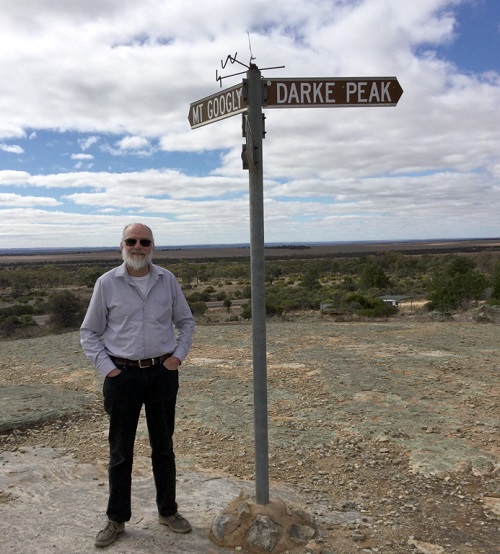
The telegraph
The telegraph was invented in 1837 and perfected by Samuel Morse in 1844. The first telegraph line in Australia was built in Melbourne in 1853. The South Australian government was aware of the technology’s potential and in 1854 recruited Charles Todd, an experienced telegraph professional, to become head of the Electric Telegraph Department, which quickly built the first telegraph in South Australia. Adelaide and Melbourne were connected in 1858 and soon after Sydney was connected to Melbourne. Sydney was connected to Brisbane in 1860 and a direct connection from Sydney to Adelaide was completed in 1867.
Although telegraph lines criss-crossed much of the British Empire, telegrams sent from London to Sydney were written on paper and carried by ship from Sri Lanka or Singapore. In 1856, Todd proposed a telegraph line linking Adelaide to London, but not everyone was impressed by the idea. After all, who would pay for it, and would it be worth the cost? And would people pay just to get news quickly?
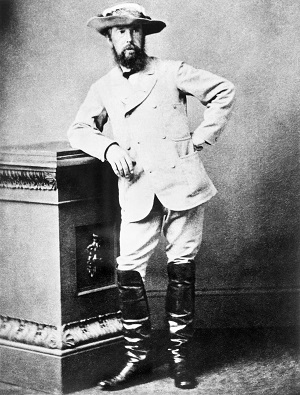
Fortunately, the advantages of international telegraphy were obvious and as the technology improved a connection from Australia to the outside world became inevitable. Not least, of course, was the potential for military use. At the time, people were concerned about the Russians, which led to the construction of Fort Denison in Sydney Harbour. A century and a half later we are still concerned about Russian aggression!
But the Australian colonies could not agree on the best route. Some wanted to connect Melbourne to Darwin (known then as Palmerston) while others wanted to connect Brisbane to Darwin. The Queensland government was keen to connect the line to Normanton and onto Darwin, but once Stuart had shown the way and the South Australian government had acquired the Northern Territory, the north-south route was preferred, driven primarily by Todd.
And of course, there was the problem of where the undersea cable would land in Australia. Some suggested North West Cape in Western Australia, but soon common sense saw Darwin chosen as the location.
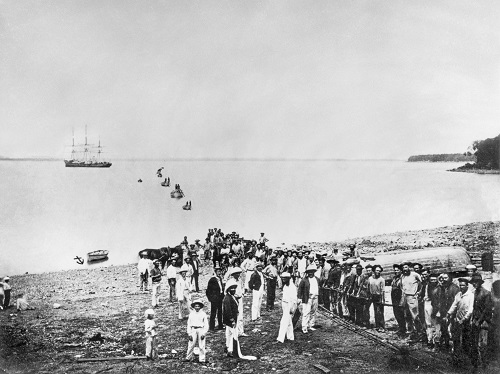
The technical aspects of the telegraph system intrigue me. It relied on electricity, and this had to be supplied by batteries. Power was produced by a chemical reaction between copper sulphate crystals and magnesium sulphate on the zinc and lead electrodes. All supplies, including batteries and building materials, were transported by camel trains and bullock drays, taking months in some cases.
Repeater stations were needed about every 320 kilometres to ensure the messages were relayed onwards to their destination. And the line itself required poles at twenty to the mile; one pole every 80 metres. Poles were to be 6 metres tall, buried about 1.5 metres into the ground. Locally sourced timber poles were to be used where possible, otherwise expensive German-manufactured Oppenheimer poles were employed. Termites loved the timber poles so, over time, most of them were replaced with metal poles.
It was a huge project, completed largely on time and within budget — conceived, planned and built in less than 10 years. It was a magnificent achievement under the most difficult of circumstances.
Revisiting the OTL
On returning from our road trip through the Red Centre, my research led to yet another fascinating book about the OTL — Rediscovering the Overland Telegraph Line by Earl and Wendy James. Earl is a well-known Territorian surveyor. In 1984 he and his wife Wendy undertook a month-long recce of the OTL and wrote their book, a copy of which I borrowed from Charles Darwin University. They write:
Australia in the mid-nineteenth century was in a hieroglyphic world where all communication with the outside world was done by hand — the written word. Communications from London took upwards of three months to arrive. It was obvious that a telegraph cable connection had to be made to Australia and the South Australian government was determined that it would come through Darwin and onto Adelaide. In 1869 The SA government sent the SA Surveyor General Goyder and a team of surveyors to select and survey a site for the capital of the Northern Territory and the place where the undersea cable would come ashore. Goyder selected Port Darwin as the site and there he and his surveyors pegged the Town of Palmerston on the plateau above the port. To the south they pegged enough rural lots, mostly three hundred and twenty acres in area, to satisfy the land orders that had been sold.
Many years later, Earl’s surveying firm was instructed to subdivide one of these original parcels of land.
In 1984, Earl was commissioned by the National Trust to undertake a reconnaissance survey and report on the original OTL with a view to declaring it a heritage item as a Bicentennial project. Earl presented a paper on the project to the South East Asian Survey Conference in Hong Kong in 2003.
Earl relates an absorbing tale of how he and Wendy spent a month tracing, finding and recording the remains of the OTL from Darwin to Alice Springs after researching the local survey records for maps and field notes of the early surveys.
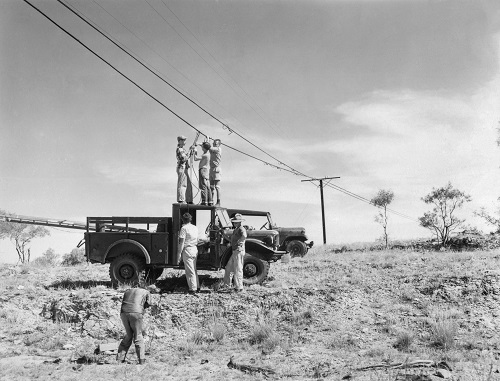
He was delighted to discover that early editions of the 1:250,000 topo maps showed the route of the OTL. A colleague over-drew the boundaries of the cattle stations along the route, adding the names of the station owners and managers, which proved to be very valuable information.
They also found the survey records, including the original maps by Mr Surveyor McAlister Blain, who surveyed the line from Tennant Creek to Alice Springs in 1930. Blain was a remarkable character… a surveyor, soldier, prisoner of war and Member of Parliament. He served in both World Wars and was re-elected to parliament while incarcerated in a POW camp. Extraordinary but true.
Harsh history
There are many stories about the OTL, one of the most moving of which concerns the events at the Barrow Creek repeater station about 280 kilometres north of Alice Springs. In early 1874, a group of local Aborigines attacked the staff at the station, killing two, including the officer in charge. As he lay dying, instructions were requested by telegraph about how to treat the wounded. But the officer died having sent a final message to his family.
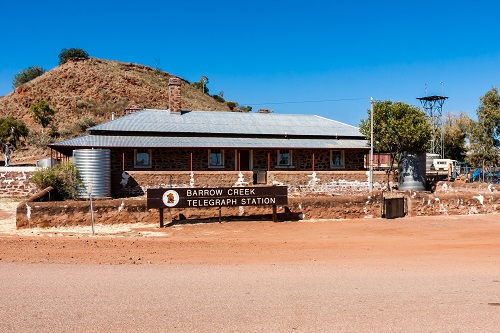
The reason for the attack is unclear. It was suggested that the attackers had asked for food, which had been refused. Others suggested that it was revenge for the rape of a local woman, while still others say it was because the staff of the OTL had denied the locals access to an important waterhole. Whatever the reason, it was tragic. Today, you can read about the event at the old repeater station at Barrow Creek adjacent to the Stuart Highway. It is reported that in a reprisal attack, 50 local aborigines were massacred. In his book, Pugh states unequivocally that the murders and retribution massacres were a travesty.
The James’ concludes their book by writing of their admiration for the men and woman who helped complete the OTL project under some of the harshest conditions on Earth.
As the Australian people prepare to vote on ‘The Voice’ to parliament, we must acknowledge the traditional owners of the land through which the OTL traversed. They had no say whatsoever and, of course, they sometimes resisted the onslaught of the white people who came and occupied their country. Who can blame them? They can only have watched in wonder and amazement as the thin strand of wire, which gave a ‘kick’ when touched, passed through their ancient land. It was only 150 years ago, yet it changed Australia forever.







